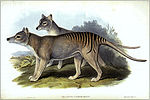 | the 1980s, decreases in amphibian populations, including population decline and localized mass extinctions, have been observed in locations all over the... 42 KB (4,531 words) - 16:03, 26 March 2024 |
subdivisions of world populations assessed separately by the IUCN for their conservation status are: Marsh deer (three populations assessed) Blue whale... 12 KB (1,277 words) - 05:55, 16 April 2024 |
 | extinctions by year List of extinct dog breeds List of recently extinct amphibians List of recently extinct arthropods List of recently extinct fishes List... 3 KB (331 words) - 19:22, 25 April 2024 |
 | Batrachochytrium dendrobatidis (redirect from Amphibian chytrid) in 1998 by Lee Berger, the disease devastated amphibian populations around the world, in a global decline towards multiple extinctions, part of the Holocene... 37 KB (4,274 words) - 00:51, 23 April 2024 |
 | Chytridiomycosis (category Amphibian diseases) contributing factor to a global decline in amphibian populations that apparently has affected about 30% of the amphibian species of the world. Some research... 52 KB (5,765 words) - 19:11, 1 March 2024 |
Small populations can behave differently from larger populations. They are often the result of population bottlenecks from larger populations, leading... 17 KB (2,241 words) - 20:06, 11 April 2024 |
Animalia) — IUCN Red List endangered species (Animalia) Amphibians — List of endangered amphibians Birds — List of endangered birds Fish — List of endangered... 2 KB (160 words) - 17:26, 26 December 2022 |
 | 31,821 populations of 5,230 species of mammal, bird, reptile, amphibian and fish. According to the 2022 report, monitored wildlife populations show an... 17 KB (1,756 words) - 11:45, 26 March 2024 |
Red List Critically Endangered species (Animalia) Amphibians — List of critically endangered amphibians Birds — List of critically endangered birds Fish... 2 KB (184 words) - 17:26, 26 December 2022 |
 | Biodiversity loss (redirect from Decline in biodiversity) the 1980s, decreases in amphibian populations, including population decline and localized mass extinctions, have been observed in locations all over the... 121 KB (14,638 words) - 04:15, 9 April 2024 |
 | Endangered species (IUCN status) (category Articles lacking in-text citations from May 2020) in their known native ranges in the near future. On the IUCN Red List, endangered is the second-most severe conservation status for wild populations in... 10 KB (1,213 words) - 23:45, 2 April 2024 |
Exploding animal (redirect from Exploding amphibian) portal Animal-borne bomb attacks Autothysis Blast fishing Decline in amphibian populations Military animals as living bombs Raining animals Self-destruct... 11 KB (1,326 words) - 17:18, 31 March 2024 |
 | Holocene extinction (category Wikipedia articles in need of updating from March 2022) ocean acidification, the destruction of wetlands, and the decline in amphibian populations, among others, are a few broader examples of global biodiversity... 223 KB (22,815 words) - 09:51, 28 April 2024 |
 | IUCN Red List (category 1964 in the environment) appeared covered reptiles and amphibians. It was created by René E. Honegger in 1968. In 1970 the IUCN published its fifth volume in this series. This was the... 28 KB (2,546 words) - 14:42, 19 April 2024 |
 | Conservation status (section The Convention on International Trade in Endangered Species of Wild Fauna and Flora) through criteria such as rate of decline, population size, area of geographic distribution, and degree of population and distribution fragmentation. Also... 14 KB (1,625 words) - 16:13, 23 April 2024 |
Animalia) — IUCN Red List vulnerable species (Animalia) Amphibians — List of vulnerable amphibians Birds — List of vulnerable birds Fish — List of vulnerable... 2 KB (152 words) - 03:55, 18 April 2022 |
 | Habitat destruction (section On human population) 1995. Beebee, Trevor J.C.; Griffiths, Richard A. (31 May 2005). "The amphibian decline crisis: A watershed for conservation biology?". Biological Conservation... 64 KB (7,149 words) - 04:15, 22 April 2024 |
 | Endangered species (redirect from Endangered species in the United States) assessed and found to have relatively robust and healthy populations, though these may be in decline. Unlike their more general use elsewhere, the List uses... 46 KB (4,758 words) - 21:32, 27 April 2024 |
that exposed populations invariably become extinct or decline heavily. However, that species may not be vulnerable if it occurs only in areas where exposure... 2 KB (185 words) - 10:43, 4 January 2024 |








